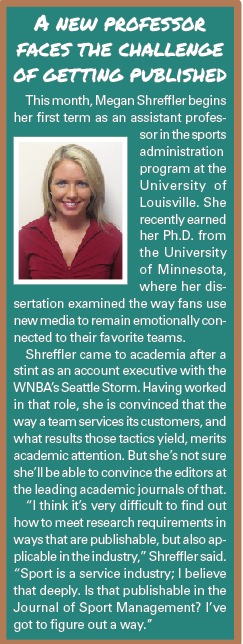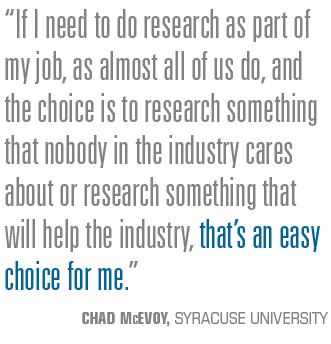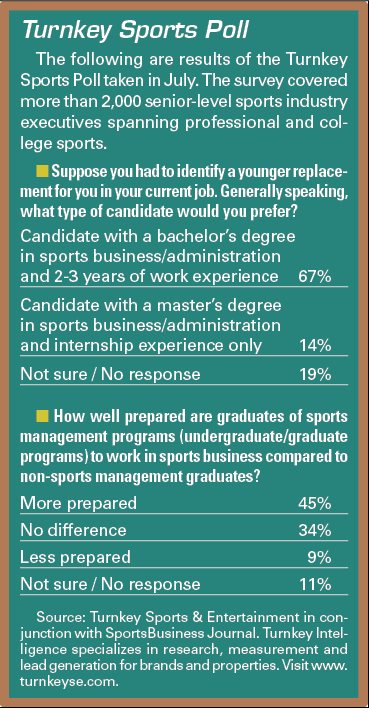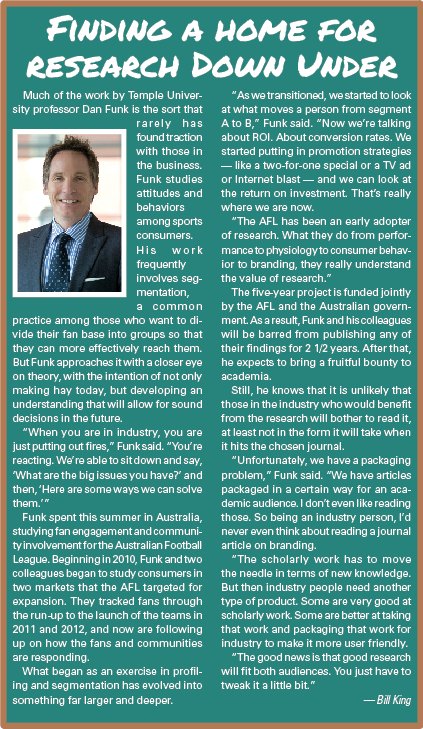When the conversation in one of the sports management classes he teaches at Temple University turns to the burgeoning field of data analytics, Joris Drayer regales his students with stories of long days and nights sorting through numbers as an assistant in the Oakland A’s front office, smack at the dawning of Moneyball.
Drayer worked for the A’s while in college, first in the marketing department as an undergrad and then as an analyst in baseball operations while getting his master’s at the University of San Francisco.
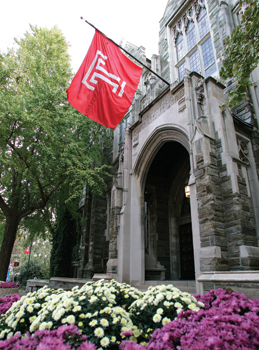 |
Making the transition from the classroom to the real world continues to vex professors at sports management programs. They want to see their research used in more than academic journals.
Photo by: Temple University |
When graduation came and he hadn’t landed a full-time baseball gig, Drayer opted for his fallback plan, the pursuit of a Ph.D. at the University of Northern Colorado and a career in academia. There, he stumbled upon a research niche. After scoring tickets to the 2005 AFC championship game between the Denver Broncos and Pittsburgh Steelers, he saw prices soar on StubHub.
Eight hours after buying the seats, he sold them, quintupling his money.
It struck Drayer that the economic model that had underpinned the sale of event tickets for a century was in the midst of a seismic shift. “An Analysis of the Primary and Secondary Ticket Markets for a National Football League Team: A Case Study of the Denver Broncos” became his doctoral dissertation.
The price of a ticket became his niche.
“One of the things I love about this pricing research is that it does connect to what people are doing in the industry every day,” said Drayer, who in six years as a university professor has published seven papers on the topic. “I love how you can connect true hard science to industry to help them drive decisions.”
In an odd twist emblematic of the disconnect between those who work in sports and those who study it, the best of that work will not necessarily advance his career as a professor, although thus far it has.
“Publish or perish,” is a phrase that has made the rounds of academia for nearly a century. It refers to the chief demand that most institutions place upon professors: the publication of scholarly work in academic journals, such as the three that are most common in U.S. sports circles — the Journal of Sport Management, Sport Marketing Quarterly, and the International Journal of Sport Management — or, more broadly in business, the Journal of Marketing, which is published by the American Marketing Association.
Publication in peer-reviewed journals is the primary currency of academia. It gets professors hired, promoted and
tenured. Nothing — save perhaps the landing of a seven-figure research grant — floats a dean’s boat like minting, or plucking, an acknowledged expert in a field.
Get published. Present at an academic or industry conference. Appear during a segment on NPR or CNN. All of those go onto the plus side of a professor’s evaluation ledger.
Fail to publish often enough in the “right” journals and it’s likely you will be asked to leave.
This is not the case at all universities, or within all programs or pursuits. Some schools emphasize teaching far more than research. But “publish or perish” is the general rule.
As a result, Ph.D.s at most major U.S. universities and many smaller colleges spend large swaths of their time working on scholarly papers to submit to academic journals. That means that those who study and teach the disciplines of the sports business are asking many of the questions facing executives in all corners of the industry: marketing, finance, law, event organization, communications — studies that can delve into every department of any sport.
Consider these six papers published in the last year in the three leading sports journals:
■ Sport Sponsorship: The Relationship Between Team Loyalty, Sponsorship Awareness, Attitude Toward the Sponsor and Purchase Intentions
■ Impulsive Purchasing Behavior for Professional Sports Team-Licensed Merchandise — From the Perspective of Group Effects
■ Brand Architecture, Drivers of Consumer Involvement, and Brand Loyalty With Professional Sport Leagues and Teams
■ Examining the Financial Impact of Alcohol Sales on Football Game Days: A Case Study of a Major Football Program
■ Salary Equalization for Baseball Free Agents Confronting Different State Tax Regimes
■ International Fans’ Motivations for Following U.S. Sports: An Investigation of College Students in Taiwan
Smart people studying pivotal issues from the sports business, every day. And yet, by many accounts, their work goes mostly unnoticed by those making their living from sports.
The disconnect stems from conflicting needs and long-standing attitudes on both sides.
Reading an academic paper can be heavy lifting. Even the more devout scholars concede that it can be a mind-numbing session.
There also is the unfortunate fact that most scholarly papers raise as many questions as they answer. Those that reveal a trend or offer a solution often do so based on a relatively small sample size. Many move the discussion forward, but few reach the final destination.
Still, those professors who have had success working with sports properties say there is much work coming from the campus that would be of value to executives.
“What we do, while it should always be scholarly, ought to inform and be relatable to those in the industry,” said Gregg Bennett, a former college baseball coach who now is a tenured professor in the health and kinesiology department at Texas A&M. “If not, we fail. If there is research out there and they can’t understand it or don’t see how they can implement it in their own way, we failed.
“At the same time, I think they fail in that they don’t rely on us enough. They don’t seek us out. They don’t trust us to do the types of things they need done, which we can do. And so there’s this large chasm between what we teach and do and what they do. There are some terrific scholars who could really help business practice. And I wish both sides of it did a much better job of getting together.”
Selecting the right topics
Much of Drayer’s work, first at the University of Memphis and now at Temple, has built upon his doctoral dissertation on ticket pricing. Three years ago, he took a deep dive into the team that pioneered variable pricing, the San Francisco Giants.
Working in tandem with Old Dominion professor Stephen Shapiro, Drayer tracked prices for a dozen games, a cross-section that included various days of the week and levels of opponent, looking at 15 seating sections over seven different time periods.
“We got an insane amount of data and some good publications out of it,” said Drayer, who has earned tenure at Temple. “But I’d hope we could do something that could be put to use by a team. Academic publishing helps me get tenured and promoted. But you’d also like to produce something that the industry cares about.”
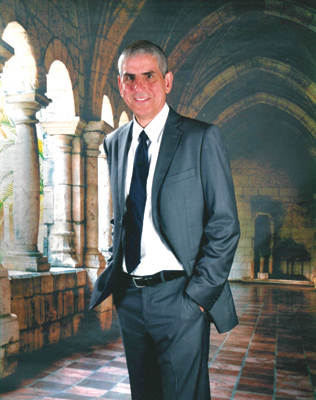 |
| Laurence Chalip, a professor at Illinois, believes that scholars can, and should, be of use to both academia and the industry. |
Laurence Chalip has directed sports management programs at the University of Maryland, at Griffith University in Australia, at the University of Texas and, since last year, as an endowed professor at the University of Illinois. His research examines what communities derive from hosting sporting events, looking not only at economic benefits but also social benefits.
He worries that, as more professors tilt their research and curriculum toward the study of today’s industry practices, they may slight what he sees as a core purpose of academic research: the advancement of strategies that will move the business forward.
“We’ve been too quick to teach the sport management of this year and that year, instead of the future,” Chalip said. “Many of our programs have done a dismal job of thinking about, ‘OK, what are the important concerns in the field? What do we know and not know? How can we position our graduates to create the sports industry of the mid-21st century?’
“That gets informed by the research … and by thinking in new ways about our industry and thinking of things that may be coming down the track.”
To illustrate his point, Chalip told the story of a technical college in San Francisco that once got the attention of the dean at nearby University of California, Berkeley, because the initial placement rate of students coming out of the tech school were higher than those of Berkeley’s esteemed engineering program.
“It was the kind of school where you could stand on a bus, rip off a card and send it in to get enrolled,” Chalip said. “Berkeley saw its placement rates and freaked out. But they found that those people got into jobs pretty quickly and were well trained to do that job, but they did not have conceptual training to advance with the times. The Cal graduates got in and advanced in the field.
“We face the exact same problem in sport management if all we do is teach someone to do a job.”
Chalip is one of many scholars who argues that academic research not only can, but should, be of use to both academia and the industry.
That was the idea behind the creation of the Sport Marketing Quarterly, which launched 20 years ago with the intention of being an academic journal that would yield insights that the industry could act upon, and the Sport Marketing Association, started 10 years ago to bridge the gap between sports management faculty and industry executives. Both continue to work in that direction, but neither has made as much headway as their founders had hoped.
“With the quarterly, we tried, but the practitioners just weren’t interested in it,” said Bill Sutton, founding director of the sports and entertainment management program at the University of South Florida, who drove the start of both SMQ and the SMA. “The [SMA] has been OK because you have a conference where you can link industry practitioners in as speakers. But getting them to accept the research is harder.”
Sutton is one of a handful of academics who “crossed” at one point in their career, helping to create the NBA’s team services division during a sabbatical. He has maintained deep connections to the industry as a consultant to teams across sports. He sees — and often hears from — both sides.
“We’ve moved light years toward getting people to think about how they use data to make decisions,” Sutton said.
“The question is, now can we get everybody to embrace the academics doing their research? That’s the next step. On that one maybe we’ve got a way to go.”
Closing the gap between academia and industry
The chair of the North American Society for Sports Management’s conference on industry relations, Syracuse professor Chad McEvoy, worked in college athletic departments after getting an undergraduate degree in sports management and while earning his master’s at the University of Massachusetts. When he got his doctorate in applied statistics and research methods, he thought his work in academia would tie directly to the problems facing administrators in college sports.
For the most part, it has. In 2008, he testified in front of a Knight Commission panel on infractions, sharing results
from a study that concluded that NCAA penalties did nothing to affect the winning percentage of the programs that were sanctioned. His research on what he called the “Flutie factor” — the spike in freshman applications to a school the year after one of its players wins the Heisman Trophy — has been cited frequently.
Still, he’s bothered by the gap between the academic world and industry.
“This is the one issue I’ve been fired up about for some time,” said McEvoy, who co-authored the text “Research Methods and Design in Sport Management.” “If I need to do research as part of my job, as almost all of us do, and the choice is to research something that nobody in the industry cares about or research something that will help the industry, that’s an easy choice for me.
“I try to ask the questions that I think industry professionals are asking. To do that, you have to get out and listen.”
Earlier this year, McEvoy made what he hopes will be a significant stride in that regard. At this year’s NACDA conference, he and a colleague assembled about two dozen college athletic department administrators, many of them engaged in data and analytics, for a discussion about what sort of research might help them most.
“We asked them to talk about what’s going on, and what issues keep them up at night,” McEvoy said. “The idea is that in the coming months we will try to conduct research to answer some of the questions the industry people shared.
“When I talk to industry professionals about this, they tell me they feel like our field has too much theory and not enough application. We certainly understand that’s how many of them feel.”
UMass professor Janet Fink said that for years she was frustrated by the disconnect between those who study sports and those who work in it. Much of her work has dealt with the marketing of female athletes and women’s sports.
She would like for her work to help advance it.
Of late, she’s had what she described as an “epiphany,” the realization that professors must step outside their university confines more often if they hope to bridge the gap with industry.
“What some of the academicians don’t do a very good job of is taking our work and making it consumable for people in practice,” said Fink, who also teaches and mentors doctoral students at UMass. “But on the other hand, you have to also realize that industry, many times, if you tell them you have a new way of looking at things, they say you don’t know what it’s like because you’re not out there.
“So it goes both ways. We have to do a much better job of getting what we know out there. But industry has to be better at listening to the academy when we do bring them ideas.”
Playing the publishing game
Some disciplines within the study of sports lend themselves to practical application more easily than others.
When Dan Rascher came out of Berkeley with a Ph.D. in economics, his friends who had studied alongside him were baffled by his decision to join the sports management program at UMass as an assistant professor.
It wasn’t long before he found fertile ground in the industry, launching a consulting business that since has performed economic analysis and financial valuations related to court cases and projects involving the NFL, NBA, NHL, NASCAR, NCAA and others.
Rascher provided expert witness testimony in the Raiders case against the NFL, consulted on Brady v. NFL, worked with NASCAR on its successful defense of an antitrust claim by Kentucky Speedway and, most recently, has worked on economic analysis related to the O’Bannon class action lawsuit against the NCAA.
When he started at UMass, Rascher quickly realized that the way the industry viewed economics was far different from the way traditional economists did. UMass wanted him to teach economic impact, something he hadn’t considered. Two of his new colleagues, Sutton and Dick Irwin, who now heads the sports management program at Memphis, were working on an economic impact study for a consulting client in Texas and wanted his help.
“When I first started consulting, I didn’t really know how to make it relevant to the end user, the industry person,”
Rascher said. “None of us are trained in that way. So it took me a while to figure out what people in industry wanted, and how to present it to them in a way they can use it.”
Now the director of academic programs for the sports management program at the University of San Francisco, Rascher said he is able to translate much of his consulting work into papers that can be published in academic journals, since that work typically stems from the analysis of numbers that are available to the public.
When StubHub hired him to analyze the impact of paperless ticketing on prices in the secondary market, he published the results. When the New York Red Bulls asked for a market analysis to help them price suites and seats in their new stadium, he created a large database that he used in a published study. He’s now working on a study on how a team’s name change affects its quest for public stadium financing, based on public data he collected while hired to analyze damages that the city of Anaheim claimed when the Angels changed their name.
Not all of Rascher’s research makes it to the public forum. A few years ago, IMG hired him to develop a model to price naming rights, which became proprietary to the agency.
At San Francisco, which stresses teaching over research, Rascher said he rarely has felt pressure to publish, or to publish in one journal rather than another, though he has continued to publish throughout his time there.
He knows that’s not the case at many other large schools, and particularly at the 62 that are members of the prestigious Association of American Universities, an invitation-only organization generally regarded as the top tier of research institutions.
At the University of Oregon, an AAU member since 1969, sports marketing professor Bob Madrigal has over the last two decades published some of the more thought-provoking work in his field. Early in his career he developed a scale that forwarded the understanding of the psychology of the sports fan, a piece of work that he and others have built upon.
Of late, he has been forced to shift his research to broader marketing topics, told by business school administrators that he would not advance from tenured associate professor to full professor unless more of his work was published in broader marketing and advertising journals.
 |
| Oregon’s Bob Madrigal has been forced to shift his research to marketing topics that appeal to the broader marketing and advertising journals that play into tenure requirements. |
his is another piece of the publishing game. All journals are not created equal. And all deans do not gauge them in the same way.
Though he knew the odds of getting a pure sports paper into a broader marketing journal were long, Madrigal remained hopeful that, with the right project, he could cross over. He thought he had it recently with a strain of research that examined the way the suspense of a game affects enjoyment.
“That’s where I made my last stand,” Madrigal said. “I’ve invested years into the suspense stuff, because in my mind it is the reason people watch sports. If people are highly identified [aka avid fans], they will care more. If they care more, there will be more suspense. You’re nervous. There are alternations between hope and fear. See something good, I’m hopeful. Something not so good, I’m fearful we’re going to lose. That is the experience.
“When things work out, you have this great feeling of joy mixed with relief. And that relief kicks in the joy. And that is the experience. That’s what we tried to sell to the marketing journals. It went through three reviews before they said no thanks.”
Now, Madrigal says he will go back to trying to find ways to integrate that sort of sports-oriented research into a broader framework that general marketing and advertising journals are accustomed to seeing.
“Research is an enormous part of what you do at an AAU institution,” said Bennett, who is tenured at AAU-member Texas A&M. “When it comes down to it, it’s the only capital that really matters. If you don’t invest in that as a scholar, then you’re really not developing your career real well to move and get to where you need to be and move up the ladder.
“A&M hires scholars. The teaching and service aspects are expected. But then really what we want is for you to develop and do research and get grants and do prominent things that help solve problems and issues.”
Opportunities on the horizon?
Considering the way that the industry has spurned research that examines its problems without offering concrete, actionable solutions, this story shouldn’t end without proposing one.
It comes from Madrigal, the Oregon professor, who long has wanted to test some of his theories against the in-house data held by teams and leagues. Professors rarely get that opportunity, because the properties don’t want their findings published.
The same concern exists in other industries. Business school professors complain of a similar gap. That’s one reason, 42 years ago, 29 companies joined to found the Marketing Science Institute, a nonprofit institution created to bridge the gap between theory and industry practice. Now made up of many of the nation’s larger companies, the institute funds studies on issues of importance to industry, distributing the findings to members.
Madrigal suggested that a similar structure, funded in consortium by the major properties across sports, could help address many of the questions and issues shared by the properties and those who do business with them, such as networks and sponsors.
“There’s money out there now to do consulting projects that are very specific and very proprietary,” Madrigal said. “If you had a sort of structure, with everyone kicking in a few bucks and a clearing house that handled how it was all allocated, you could get the academic side and the industry side further down the road on the larger questions.
“That’s something everyone could benefit from.”





